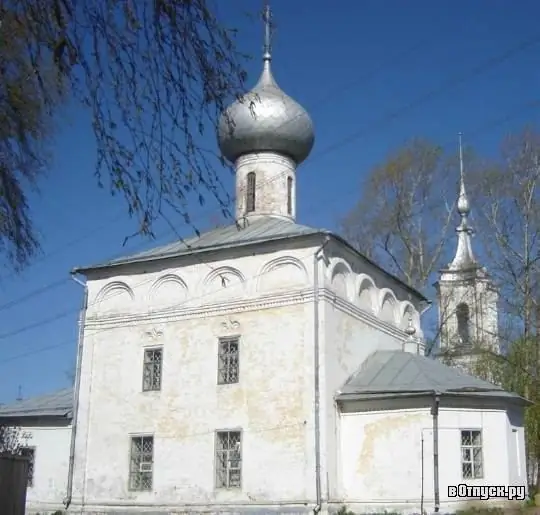
Description of the attraction
On the site of the Church of Elijah the Prophet in Kamenya in the 16th century there was a monastery (the exact date of the foundation of the monastery has not been established). The Old Testament prophet Elijah is one of the most revered saints in Russia.
There are two versions of the origin of the name "Stone". It is associated with the activities of Ivan the Terrible. "Kamenye" is a locality in the Upper Posad of the city of Vologda, which got its name from the limestone warehouses. The stone was intended for the Vologda Kremlin, which Tsar Ivan the Terrible wanted to build. He wanted to settle here and found a capital. However, construction was suspended (the stone went into the ground from its weight). This limestone was used for the construction of various city buildings in Vologda. Another version is as follows: it is believed that once, on the site of the holy monastery, there was a pagan temple. However, these assumptions are not supported by reliable historical sources.
In the 16th century, on the site of the parish church, there was a small Ilyinsky monastery. An ancient letter has been preserved, which indicated the state of the monastery: the abbot and 23 monks. The monastery was not rich, and the merchant Kondraty Akishev was the “beautifier, beautifier and donor” of the monastery. In 1613 Lithuanians attacked Vologda, and the monastery was destroyed and plundered. The warm and ancient church in the name of St. Varlaam of Khutynsky was mercilessly burned down, but a new church in the name of the Holy Prophet Elijah survived. Later, the monastery was again rebuilt at the expense of the same donor-merchant Kondraty Akishev and surrounded by a wooden fence. Over time, the wooden church of the Holy Prophet Elijah fell into decay (it existed for about 90 years), and in 1698 a new stone church was built, which has survived to this day.
In 1738 the monastery was abolished (there were no brethren left in it, only the abbot), and the church, as usual, was converted into a parish. This modest little church is extremely interesting architecturally. It makes a more vivid impression than the stately and large churches. The temple is cubic in shape, proportional, white, one-story, covered with a simple roof, it is crowned with one chapter with a large dome. There is a pentahedral apse (rebuilt in 1904) and a refectory; zakomaras are on top of the walls. Decor - shoulder blades located in the corners, and cornice with kokoshniks. The four-tiered Baroque iconostasis was built in the 18th century at a high professional level. It is distinguished by its simplicity and grace. Its wooden columns are beautifully decorated with branches and fruits, their design is original. From the icons, the images of the Prepolovanie of the Feast of the Lord (located to the right of the royal gates) and the Resurrection of the Lord (written in 1568) stand out. The icon of the Ascension of the Lord is divided into two halves by a vertical stripe, these halves are divided into squares. In the right half there is an image of the Savior's Descent into Hell, and around there are scenes from the Gospel story. In the left half, the ancestors of the Lord Jesus Christ, the “root of Jesse,” are represented, and in small squares the twelve church feasts are shown. The icon of the temple saint - the prophet Elijah with his life deserves attention.
In 1930, St. Elias Church, like most Russian churches, suffered a sad fate: it was closed by the Soviet government. At first, it housed an archive, and later - restoration workshops. The temple was rebuilt and renovated in 1999-2000. The Elias Church of the late 17th century is an architectural and Orthodox cultural monument of the city of Vologda.






